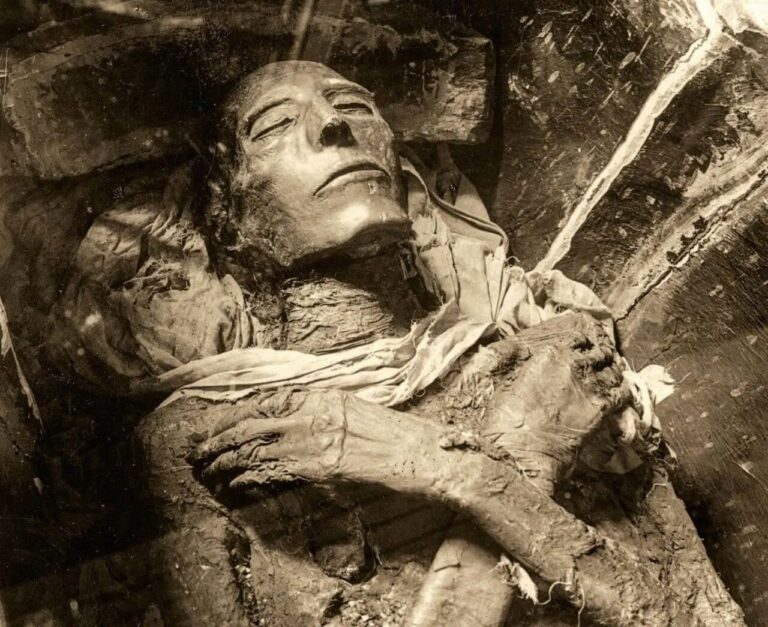In the heart of ancient Egypt, a discovery of monumental significance emerged, captivating historians and archaeologists for generations. The unearthing of the mummy of Seti I, a distinguished pharaoh of the 19th Dynasty, provided an extraordinary glimpse into the life, death, and legacy of one of ancient Egypt’s most powerful rulers.
Seti I’s burial was initially a scene of splendor, with his remains interred in an exquisite alabaster sarcophagus in the Valley of the Kings. This final resting place, however, was not destined to be eternal. As centuries passed, the pharaoh’s mummy was relocated to the Deir el-Bahari Cachette. This transfer, while seemingly a disruption, ultimately preserved his remains for future generations to study. Despite the inevitable ravages of time and the interference of tomb robbers, who separated his skull from his body, Seti I’s head remained astonishingly well-preserved. However, his body suffered more extensive damage, bearing the marks of both human and environmental interference.

When experts examined Seti I’s mummy, they uncovered a startling revelation: the mighty ruler had died unexpectedly before reaching his fortieth year. The cause of his untimely demise remains cloaked in mystery. Notably, there was no evidence of violence on his remains, leaving Egyptologists to speculate endlessly about the circumstances of his passing. The enigma of Seti I’s death continues to fuel academic debates, offering a tantalizing puzzle for scholars of ancient Egyptian history.
Seti I’s life and reign were characterized by remarkable achievements, particularly in the realms of military conquest and cultural advancement. As a ruler, he commanded respect and fear, leading significant military campaigns that extended Egypt’s borders and influence. His expeditions into Canaan, Nubia, and Libya not only secured Egypt’s dominance but also stabilized its political landscape. These military endeavors reinforced Egypt’s role as a formidable power in the ancient world. However, Seti I’s legacy transcends his battlefield victories.
A key hallmark of Seti I’s reign was his dedication to architectural innovation and cultural flourishing. The pharaoh’s passion for grand construction projects transformed Egypt’s landscape. Among his most notable contributions was his work on the Temple of Karnak. There, Seti I added stunning structures and intricate decorations that remain a testament to his vision. Beyond Karnak, he commissioned temples and restoration projects across Egypt, breathing new life into the nation’s artistic and architectural traditions.
Seti I’s reign marked a renaissance in Egyptian art and craftsmanship. Under his patronage, skilled artisans created intricate reliefs and statues that captured the grandeur of his era. These masterpieces continue to inspire awe in modern observers, underscoring the cultural vibrancy that flourished during his rule. His contributions to Egypt’s artistic heritage were not merely ornamental; they were expressions of a ruler deeply invested in the spiritual and cultural identity of his people.
While Seti I’s achievements were substantial, his most enduring legacy lies in the dynasty he helped solidify. His son, Ramesses II, would go on to become one of ancient Egypt’s most renowned pharaohs. Often referred to as Ramesses the Great, his long and prosperous reign epitomized the golden age of the 19th Dynasty. Seti I’s accomplishments laid the foundation for this remarkable period, ensuring the stability and prosperity that his successors would build upon. Through his son, Seti I’s influence extended far beyond his lifetime, shaping the course of Egyptian history for decades to come.
Today, the mummy of Seti I resides in the National Museum of Egyptian Civilization in Cairo. This resting place is more than a repository for ancient remains; it is a gateway to understanding the intricate tapestry of New Kingdom Egypt. The study of Seti I’s mummy has provided invaluable insights into the burial practices, religious beliefs, and daily life of the period. The artifacts and remains associated with Seti I offer a window into a world long past, enriching our understanding of ancient Egyptian civilization.
The preservation and analysis of Seti I’s remains underscore the enduring fascination with ancient Egypt. Through meticulous study, archaeologists and historians have pieced together fragments of his story, offering modern audiences a glimpse into the life of a pharaoh who shaped his nation’s destiny. Each discovery, whether a piece of art, a fragment of a sarcophagus, or the intricate details of his mummy, contributes to a more comprehensive understanding of his era.
Seti I’s legacy serves as a reminder of the enduring impact of ancient Egypt on world culture. The pharaoh’s reign, marked by military prowess, architectural brilliance, and cultural renewal, continues to resonate through the ages. His life and achievements are a testament to the ingenuity and ambition that defined ancient Egyptian civilization. As we delve deeper into the mysteries of Seti I’s life and reign, we not only honor his memory but also gain a deeper appreciation for the complex and vibrant world he inhabited.
The story of Seti I is not merely a historical account; it is a narrative that bridges the past and the present. His achievements, preserved through centuries, offer lessons in leadership, resilience, and the pursuit of excellence. The fascination with his life and death reflects humanity’s enduring quest to understand our ancestors and the legacies they left behind.
Through the lens of Seti I’s story, we glimpse the grandeur of ancient Egypt and the indomitable spirit of a civilization that continues to captivate our imaginations. The preservation of his mummy and the artifacts of his reign are not merely relics of the past; they are treasures that connect us to a time when pharaohs ruled and the Nile was the lifeblood of a flourishing empire. As we continue to study and celebrate the legacy of Seti I, we ensure that the rich history of ancient Egypt remains alive for generations to come.





